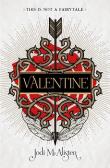 5820435414445487364.jpg
5820435414445487364.jpg
 5820435414445487364.jpg
5820435414445487364.jpg
'Strange and terrible things begin to happen to four teenagers – all born on the same Valentine’s Day. One of these teenagers is the Valentine: a Seelie fairy changeling swapped for a human child at its birth. The Unseelie have come to kill the Valentine – except they don’t know who it is.
'Pearl shares a birthday with Finn Blacklin. She’s known him all her life and disliked every second of it. Now Pearl and Finn must work together to protect themselves from the sinister forces that are seeking them out.
'But there's one more problem: the explosive chemistry between them . . .'
Source: Publisher's blurb.
Teaching resources created for AustLit by Lindsay Williams, available to AustLit subscribers.
'Australian fairy-tale masculinity in the young adult (YA) novel Valentine reinscribes modes of maleness in stereotypical forms. This article argues that the character Finn Blacklin marries European fairy lore of violent and monstrous faeries with Australian traditions of “larrikin faeries.” Through the violence associated with the Seelie Courts, and his fear of being othered or deemed feminine as a changeling faerie, Finn perpetuates hegemonic masculinity. As a modern iteration of the “larrikin” faerie, Finn reinscribes overindulgence and misogyny as standard in Australian boyhood. The characterization of Finn in Valentine therefore perpetuates stereotypical understandings of fairy-tale masculinity.' (Publication abstract)
'Australian fairy-tale masculinity in the young adult (YA) novel Valentine reinscribes modes of maleness in stereotypical forms. This article argues that the character Finn Blacklin marries European fairy lore of violent and monstrous faeries with Australian traditions of “larrikin faeries.” Through the violence associated with the Seelie Courts, and his fear of being othered or deemed feminine as a changeling faerie, Finn perpetuates hegemonic masculinity. As a modern iteration of the “larrikin” faerie, Finn reinscribes overindulgence and misogyny as standard in Australian boyhood. The characterization of Finn in Valentine therefore perpetuates stereotypical understandings of fairy-tale masculinity.' (Publication abstract)